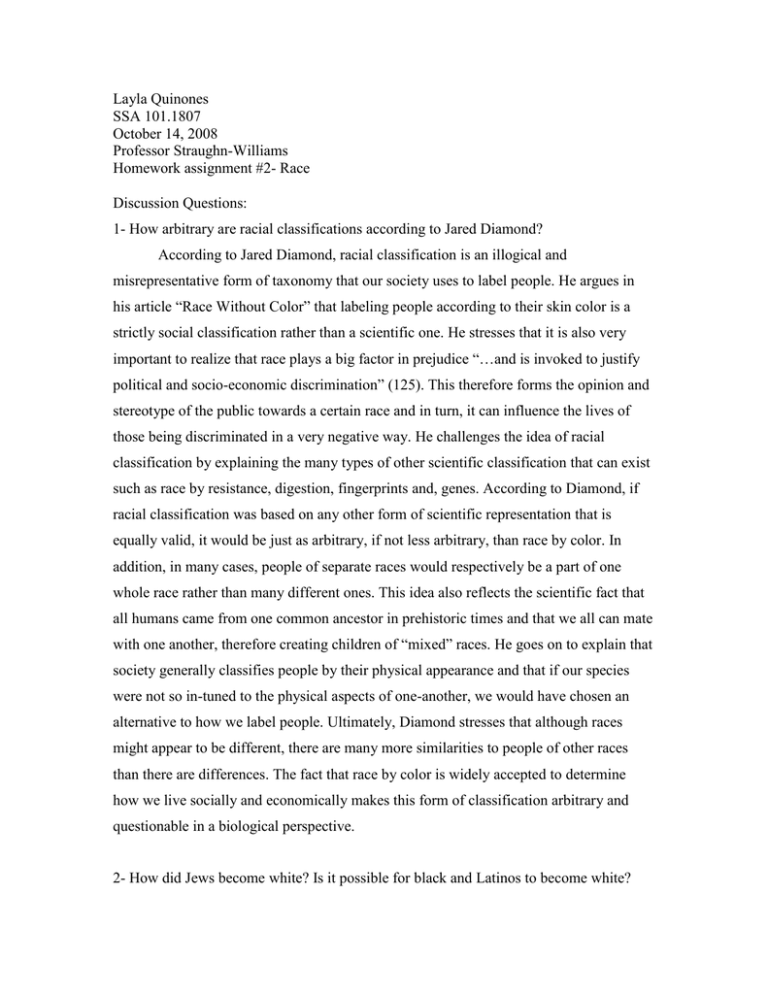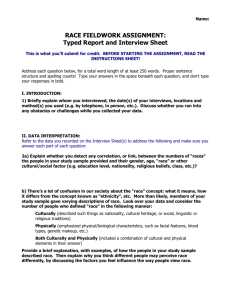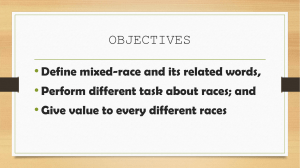Layla Quinones SSA 101.1807 October 14, 2008 Professor Straughn-Williams
advertisement

Layla Quinones SSA 101.1807 October 14, 2008 Professor Straughn-Williams Homework assignment #2- Race Discussion Questions: 1- How arbitrary are racial classifications according to Jared Diamond? According to Jared Diamond, racial classification is an illogical and misrepresentative form of taxonomy that our society uses to label people. He argues in his article “Race Without Color” that labeling people according to their skin color is a strictly social classification rather than a scientific one. He stresses that it is also very important to realize that race plays a big factor in prejudice “…and is invoked to justify political and socio-economic discrimination” (125). This therefore forms the opinion and stereotype of the public towards a certain race and in turn, it can influence the lives of those being discriminated in a very negative way. He challenges the idea of racial classification by explaining the many types of other scientific classification that can exist such as race by resistance, digestion, fingerprints and, genes. According to Diamond, if racial classification was based on any other form of scientific representation that is equally valid, it would be just as arbitrary, if not less arbitrary, than race by color. In addition, in many cases, people of separate races would respectively be a part of one whole race rather than many different ones. This idea also reflects the scientific fact that all humans came from one common ancestor in prehistoric times and that we all can mate with one another, therefore creating children of “mixed” races. He goes on to explain that society generally classifies people by their physical appearance and that if our species were not so in-tuned to the physical aspects of one-another, we would have chosen an alternative to how we label people. Ultimately, Diamond stresses that although races might appear to be different, there are many more similarities to people of other races than there are differences. The fact that race by color is widely accepted to determine how we live socially and economically makes this form of classification arbitrary and questionable in a biological perspective. 2- How did Jews become white? Is it possible for black and Latinos to become white? According to Karen Brodkin Sacks and her article “How Jews Became White Folks”, before World War I Jewish people were viewed as a separate race that “took over” many cities. They came to America and were discriminated against socially and according to scientific tests of that time, were biologically and mentally inferior to the Americans that were living in the country. However, over time Jewish people worked hard, and despite racial discrimination in schools that prevented them from getting a much sought after education, they came out of the social depression they were in and became part of the general “white” population. They achieved this status through hard work and by growing economically to create “Euro ethnic suburbs” and small businesses that contributed to the economy. Sacks also touches on the point that “Anti-Semitism and anti-European racism lost respectability” in the United States during World War II (87). Due to the thriving economy after the war, the demand for more jobs increased therefore, the country’s need for more workers also increased. This was followed by the occupations of many lower class Jewish people which paved their way into the middle working class. Jewish people made a positive name for themselves and invested in respectable professions, such as doctors, which led them to earn college degrees and to become middle class people who were viewed as active members in society. I do not believe that Blacks and Latinos can become “white” in the sense that their skin color is physically different from white people’s skin color. However, I do believe that they can definitely achieve the status of any other white person by working hard and entering the middle class by contributing to the economy. Furthermore, it would take a majority of people from these races to become middle class workers in order for the social stereotype that they are labeled by to disappear. 3- Should we promote affirmative action programs in education and employment? We definitely should promote affirmative action programs in education and employment because it is a great service to the community of minorities. Although there are many loop holes in society that come from affirmative action programs that can deem them unpleasing to majority races, they are also a key factor in the survival of minorities. Without these programs to assist people in employment and education, homelessness and poverty would prevail all over the Unites States. Although excluded in the past, minority races are now included in and treated equally when it comes to education. I also believe that through these programs, we are providing a safer education for students and providing them with jobs so that they can care for their families and develop their futures. Furthermore, due to affirmative action programs, many minorities were able to establish themselves by obtaining college degrees and moving themselves into the middle working class making it possible for them to buy houses and become a part of the white American lifestyle.



